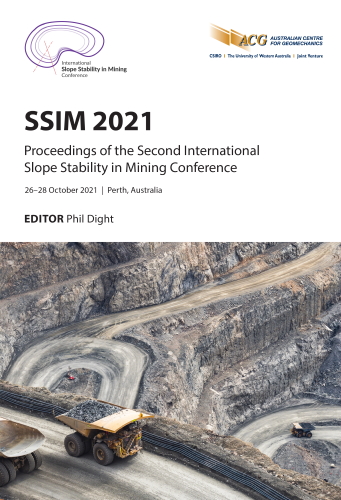Drone photogrammetry: a structural data gathering tool for open pit mining geotechnics

|
Authors: Dey, J; Roy, S; Matin, A |
DOI https://doi.org/10.36487/ACG_repo/2135_06
Cite As:
Dey, J, Roy, S & Matin, A 2021, 'Drone photogrammetry: a structural data gathering tool for open pit mining geotechnics', in PM Dight (ed.), SSIM 2021: Second International Slope Stability in Mining, Australian Centre for Geomechanics, Perth, pp. 135-148, https://doi.org/10.36487/ACG_repo/2135_06
Abstract:
Structural elements, such as folds, faults, shear zones (major structures) and closely spaced structural defects (structural fabric) determine the stability of open pit slopes. As a result, a site-specific structural model is required for reliable slope design, its implementation and management. However, attaining a robust fabric model is often difficult for lack of adequate and reliable data, and therefore, uncertainty is introduced in the resulting pit designs. To overcome data inadequacy and uncertainty, drone flights were used to develop a photogrammetry-based model of an operating limestone pit. The deposit occurs in a structurally complex terrain with varied orientation of strata and joint systems typical of a folded sequence. An automated mission plan was devised with the drone flying at a constant speed in a predefined path, maintaining a constant distance from the pit benches. Images were captured automatically with vertical, inclined, and horizontal camera angles. The high resolution, 3D photogrammetric model was processed by Datamine Sirovision package. Different lithologies, their contacts, and the fabric systems were captured through the process and were used for structural interpretation and modelling. At project scale, the deposit showed signatures of three phases of deformation: 1) a bench to sub-bench-scale isoclinal folding; 2) mine-scale upright, open folding with ~E-W trending axial plane; and 3) mine-scale cross folding with ~N-S trending axial planes. Orientation of bedding planes were largely controlled by the first order second generation folding. Sub-vertical, persistent, axial planes associated with the two major folding episodes (2 and 3) formed the most prominent structural fabric that strikes ~E-W and ~N-S, respectively. In addition, sub-horizontal, small-scale, axial planes associated with the first phase of folding were found locally alongside partially developed joint sets. Structural domains were outlined based on rock mass conditions and structural fabric. Resulting structural model helped to develop a reliable geotechnical model, established opportunities of slope steepening, and finally to develop a slope management program.
Keywords: drone application technology, unmanned aerial vehicle, photogrammetry, structural data processing, structural model, pit slope design, design uncertainty
References:
Coggan, JS, Wetherelt, A, Gwynn, XP & Flynn, Z 2007, ‘Comparison of hand mapping with remote data capture systems for effective rock mass characterisation’, Proceedings of 11th Congress of the International Society for Rock Mechanics - the Second Half Century of Rock Mechanics, vol. 1, pp. 201–205.
Cronin, VS 2008, ‘Finding the mean and 95% confidence interval of a set of strike-and-dip or lineation data’, Environmental and Engineering Geoscience, vol. 14, no. 2, pp. 113–119,
Datamine 2019, Open Pit & Underground Geological & Geotechnical Analysis Solution, viewed 25 February 2021,
Datamine 2018, Sirovision, version 6.2, computer software, Datamine International, Wells, https://www.dataminesoftware.com/
solutions/sirovision-geotechnical-mapping/
Grobler, HP, Poropat, G & Guest, AR 2003, ‘Photogrammetry for structural mapping in mining’, Technology Roadmap for Rock Mechanics, Proceedings of the 10th Congress, International Society for Rock Mechanics, Lisbon, pp. 431–436.
Haneberg, WC 2008, ‘Using close range terrestrial digital photogrammetry for 3-D rock slope modelling and discontinuity mapping in the United States’, Bulletin of Engineering Geology and the Environment, vol.67, pp. 457–469,
Haneberg, WC, Norrish, NI & Findley, DP 2006, ‘Digital outcrop characterization for 3-D structural mapping and rock slope design along Interstate 90 near Snoqualmie pass, Washington’, Proceedings of the 57th Annual Highway Geology Symposium, pp. 146–160.
Hustrulid, W, Kuchta, M & Martin, R 2013, Open Pit Mine Planning & Design, 3rd edn, CRC Press, Boca Raton.
Krosley, LK, Shaffner, PT, Oerter, E & Ortiz, T 2006, ‘Digital ground-based photogrammetry for measuring discontinuity orientations in steep rock exposures’, Proceedings of the 41st US Rock Mechanics/Geomechanics Symposium, American Rock Mechanics Association, Alexandria, pp. 1–13.
Peppa, MV, Hall, J, Goodyear, J & Mill, JP 2019, ‘Photogrammetric assessment and comparison of DJI Phantom 4 Pro and Phantom 4 RTK small unmanned Aircraft Systems’, The International Archives of the Photogrammetry, Remote Sensing and Spatial Information Sciences, vol. XLII, no. 2, pp. 10–14.
Priest, SD & Hudson, JA 1981, ‘Estimation of discontinuity spacing and trace length using scanline surveys’, International Journal of Rock Mechanics and Mining Sciences & Geomechanics, vol. 18, pp. 183–197.
Priest, SD 1993, Discontinuity Analysis for Rock Engineering, Chapman & Hall, London.
Read, J & Stacey, P 2009, Guidelines for Open Pit Slope Design, CSIRO Publishing, Clayton.
Rocscience 2016, Dips, version 6.0, computer software, Rocscience Inc, Toronto, https://www.rocscience.com/support/program-downloads
Salvini, R, Mastrorocco, G, Seddaiu, M, Rossi, D & Vanneschi, C 2016, ‘The use of an unmanned aerial vehicle for fracture mapping within a marble quarry (Carrara, Italy): photogrammetry and discrete fracture network modelling’, Geomatics, Natural Hazards and Risk, vol. 8, pp. 34–52,
Seequent 2021a, Leapfrog Geo, version 6.0.4, computer software, Seequent Limited, Christchurch, https://www.seequent.com/
products-solutions/leapfrog-geo/
Sturzenegger, M & Stead, D 2009, ‘Close-range terrestrial digital photogrammetry and terrestrial laser scanning for discontinuity characterization on rock cuts’, Engineering Geology, vol. 106, pp. 163–182,
Toth, C & Jóźków, G 2016, ‘Remote sensing platforms and sensors: a survey’, ISPRS Journal of Photogrammetry and Remote Sensing, vol. 115, pp. 22–36,
Watkins, H, Bond, CE, Healy, D & Butler, RWH 2015, ‘Appraisal of fracture sampling methods and a new workflow to characterise heterogeneous fracture networks at outcrop’, Journal of Structural Geology, vol. 72, pp. 67–82,
Westoby, MJ, Brasington, J, Glasser, NF, Hambrey, MJ & Reynolds, JM 2012, ‘Structure-from-Motion’ photogrammetry: A low-cost, effective tool for geoscience applications’, Geomorphology, vol. 179, pp. 300–314,
/j.geomorph.2012.08.021
© Copyright 2024, Australian Centre for Geomechanics (ACG), The University of Western Australia. All rights reserved.
View copyright/legal information
Please direct any queries or error reports to repository-acg@uwa.edu.au
View copyright/legal information
Please direct any queries or error reports to repository-acg@uwa.edu.au